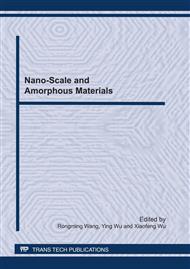p.122
p.127
p.135
p.141
p.148
p.153
p.158
p.162
p.168
Magnetic-Field-Assisted Hydrothermal Growth of Manganese Dioxide Nanostructures and their Phase Transformation
Abstract:
MnO2 nanostructures were successfully synthesized by a magnetic-field-assisted hydrothermal approach. By applying a pulsed magnetic field to the reaction system, the crystal phase transformation progress of MnO2 at different temperature has been changed comparing to those synthesized without magnetic field. The effect of pulsed magnetic field on the growth of MnO2 was investigated by tracking the phase of the sample by using X-ray diffraction. It is found the pulsed magnetic field has an obvious effect on the nucleation and growth of MnO2 nanostructures and therefore influences the phase transformation.
Info:
Periodical:
Pages:
148-152
Citation:
Online since:
June 2011
Authors:
Price:
Сopyright:
© 2011 Trans Tech Publications Ltd. All Rights Reserved
Share:
Citation:


